The All-22: Vikings’ fatal play-calling blunder echoes other NFC contenders
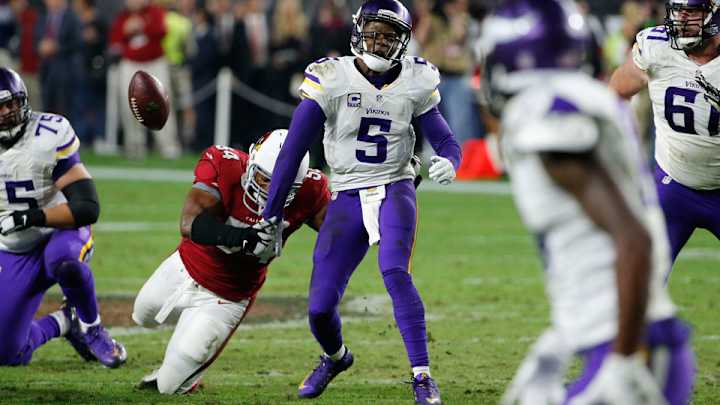
When Packers coach Mike McCarthy decided to take back play-calling responsibilities from associate head coach Tom Clements last week, it was seen as a big deal by everyone not named Mike McCarthy. The coach did the political thing and deferred to Clements, but in Green Bay’s 28–7 win over the Cowboys on Sunday, the difference was evident. The Packers dumped their limited route concepts in which their receivers struggled to get open against aggressive coverage, used more play-action, moved receiver Randall Cobb around in the formation and gave Aaron Rodgers quicker reads across the middle of the field. It was everything the Pack had been lacking before.
Similarly, Seahawks offensive coordinator Darrell Bevell has turned his playbook from a single-dimensional entity into something far more expansive in the last month, and Russell Wilson is thriving as a result. After struggling from the pocket earlier this year, Wilson has completed 81 of 99 passes for 1,094 yards, 15 touchdowns and no picks from there in his last four games. Seattle’s improvement along the offensive line has been a factor, but a passing game that once featured little more than bubble screens, curls and go routes from basic formations has grown into a monster in which receivers are schemed open from a relatively dizzying array of formations.
Why playoff teams are likely hoping Steelers stay on the outside looking in
If the Vikings are to parlay their midseason contention into any type of run in the postseason, offensive coordinator Norv Turner must take a similar step forward with his passing game and quarterback Teddy Bridgewater. Throughout most of Minnesota’s 23–20 loss to the Cardinals last Thursday night, he did just that, rolling Bridgewater out, giving him easier reads and dialing up a diverse series of concepts. Then, at the worst possible time, Turner called a play that made no sense and knocked Bridgewater back to earlier in the season, when the second-year quarterback was asked too often to make deep throws to receivers running routes in which they struggled to beat coverage.
• MAYS: Curry thinks Newton should be MVP | KING: My top 15 teams
With 13 seconds left on Thursday night, and Bridgewater had a few options. He had the ball at the Arizona 31-yard line with no timeouts and the clock stopped because he had just thrown two incomplete passes. The Vikings could have tried a game-tying 48-yard field goal from that spot—kicker Blair Walsh had made six of seven field goals from 40 yards or more, including a 44-yard field goal at the end of the first half—but the decision was made to throw the ball and give Walsh an easier look to tie the game at 23 and send it into overtime.
There were a few things Bridgewater couldn’t do in that situation: He couldn’t take a sack. He couldn’t hit a receiver in bounds, because the clock would likely have run out. His best bet would be to hit one of his targets on a quick sideline route, have the receiver get the heck out of bounds and get Walsh on the field.
Hot Seat Watch: Who’s most at risk of getting the axe come Black Monday?
Of course, that didn’t go as planned. The Vikings went with a three-by-one receiver set with five-man protection against Arizona’s four-man pass rush. Right outside linebacker Dwight Freeney demolished left tackle Matt Kalil, making Kalil look like he was on skates, and sacked Bridgewater, causing a fumble that defensive lineman Calais Campbell recovered. After one Carson Palmer kneeldown, the Cards walked off the field with an 11–2 record, while the Vikings had a long flight home to consider their 8–5 mark and 1–4 record against teams currently holding winning records. Mike Zimmer’s team had been looking for a signature win all season, and they didn’t get it in the Valley of the Sun.
A strip-sack seems like a simple, isolated play, but when you peel away the layers, the tape shows a pretty stunning breakdown between quarterback and coaching staff. The Vikings had four receivers streaking downfield, and none of them were near either sideline. Here’s the picture after Bridgewater had taken three steps from center:
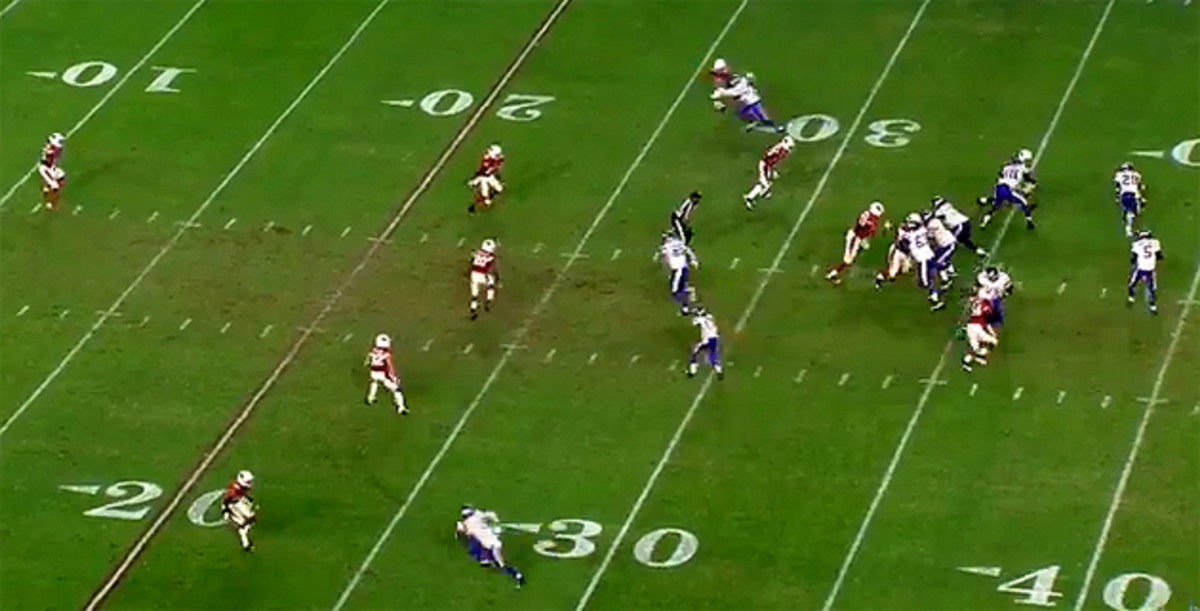
And here’s the picture after seven steps:
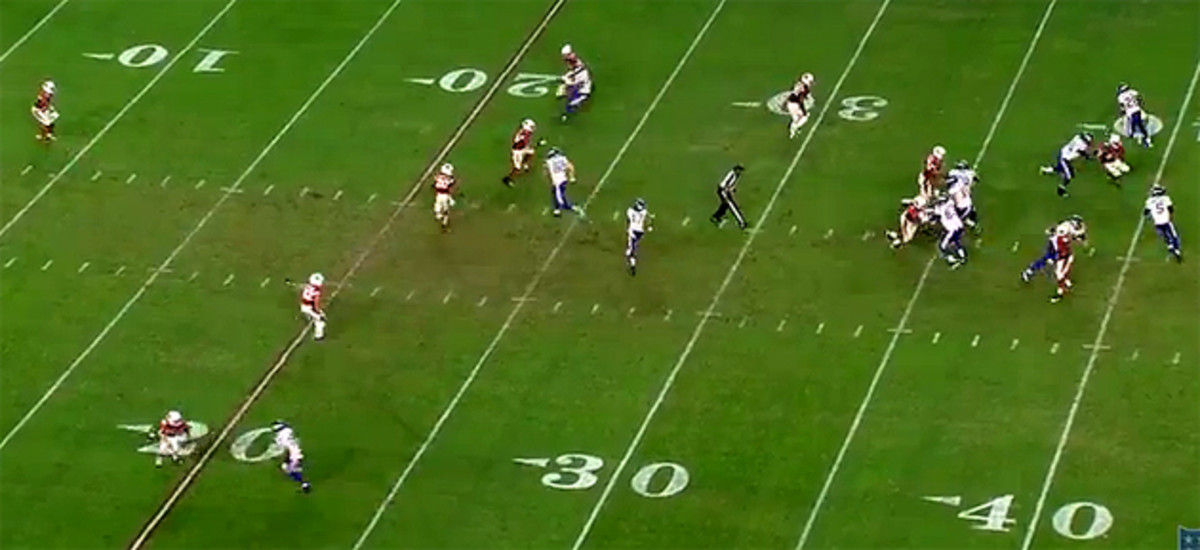
So here, you can see that the Cardinals are essentially conceding the sideline routes with their coverage concepts—a quick comeback to the edge would have most likely worked—but there’s nobody there. Moreover, when Bridgewater is on his back foot, Freeney is halfway through his spin move and less than a second from the takedown. There’s simply no way this play works, and that’s by design. You can fault Bridgewater for not throwing it away, but other than that, this is on offensive coordinator Norv Turner. Bridgewater held the ball for 3.22 seconds, according to ESPN Stats & Info, but what was he supposed to do? He knew that unless someone came clear on a blown coverage, any receiver he hit would have been met with a tackle and the end of the game.
“We didn’t have any timeouts, couldn’t afford to get tackled in bounds,” Bridgewater said after the game. “The play was designed to push the ball down a little and allow our guy to make the catch and get out of bounds. I had that clock going off in my head. I was ready to throw.”
On Friday, Zimmer went deeper into the strategy.
Week 15 Waiver Wire: Players to grab in wake of injury to Thomas Rawls
“If I knew that was going to happen, I probably would have done something different,” he said. “I thought about kicking the field goal with the 13 seconds left on the clock, if we missed the field goal, I’m wrong, we should have got closer. I did the best that I thought we could at that particular time. We’ve studied that situation many times; to clock the ball inbounds it’s approximately 12–14 seconds, so we were right on the verge. I didn’t feel like there was any way we could throw the ball inbounds and still get another play off. We were trying to get a little closer, a play designed to get the sideline.
“Actually, the play before was a very similar play—there were 18 seconds left on the clock, we knew we had time to clock it at that point, but we tried to get the ball to the sideline and it wasn’t there and [Bridgewater] threw it out of bounds. It took five seconds, so then it went to 13. I felt good about that, and if we didn’t get it I figured we could try the field goal from there and take a shot.”
Was the previous play similar? Well, not really. The Vikings had run a bunch right formation, with tight end Kyle Rudolph and receiver Jarius Wright breaking to the sideline. Here, Bridgewater had two open targets he could have potentially hit.
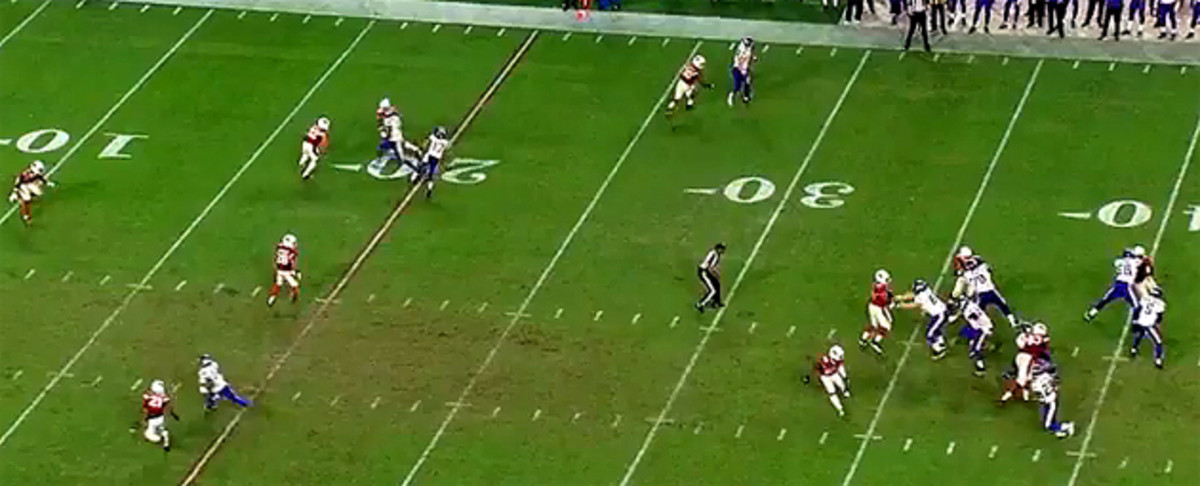
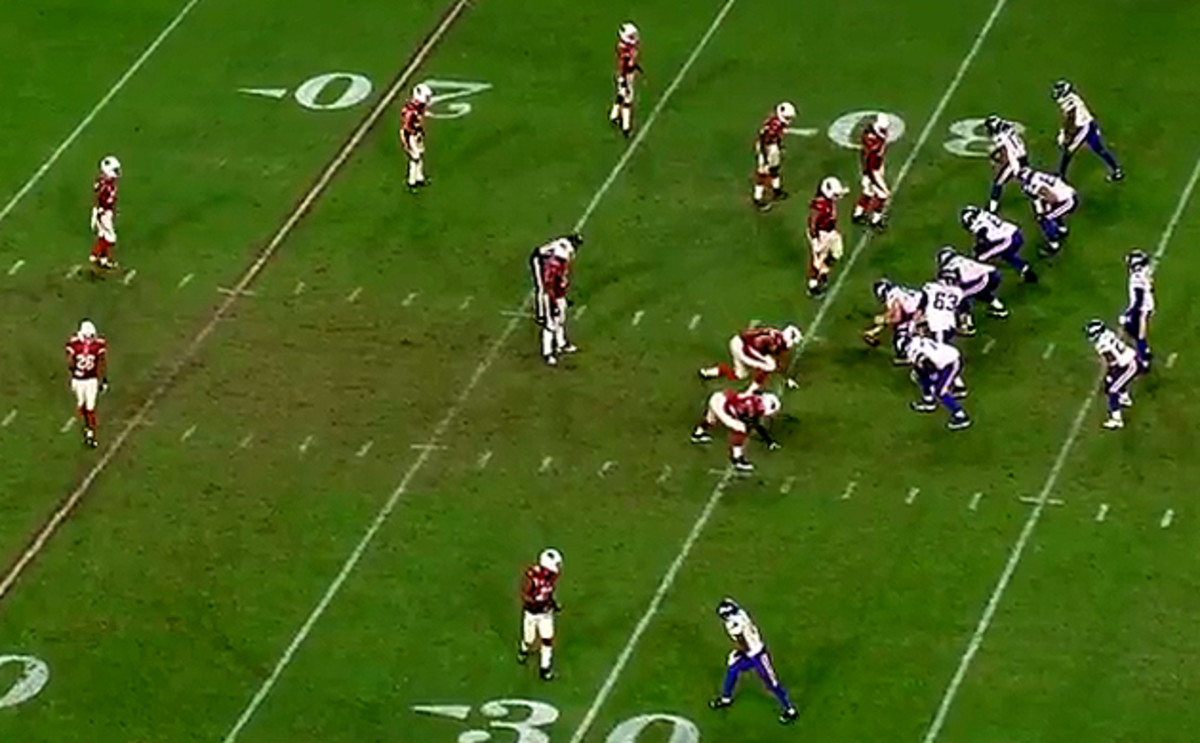
It was a shame of an ending to one of Bridgewater’s best games as a pro—he completed 25 of 36 passes for 335 yards and a touchdown. Not bad for a guy who had thrown for fewer than 200 yards in seven of his 13 games this season. Bridgewater was helped by Turner’s updated concepts through most of the game, but it was a reversion to the vertical route—and an odd lapse in situational football awareness—that doomed the Vikings on their last offense play. As Green Bay and Seattle know well, Minnesota’s fate came straight out of the playbook.
